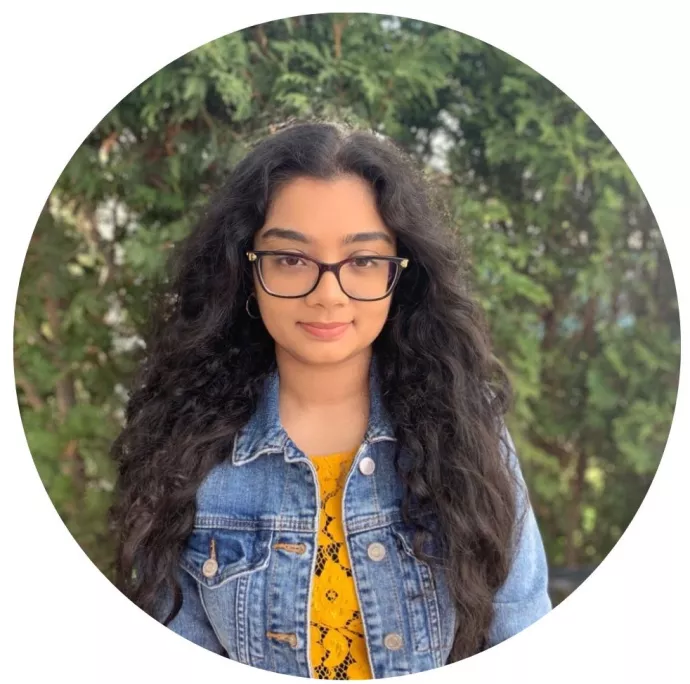
CPS Grad Spotlight - Karishma Kailass
Name: Karishma Kailass
MSc or PhD Candidate: PhD Candidate
Location of Undergraduate Education: H.B.Sc., University of Toronto Mississauga
Name of the Lab at CPS: Beharry Lab
Selected Awards: NSERC Post-Graduate Scholarship - Doctoral, NSERC Canada Graduate Scholarship - Master's, Huguette Cohen Award
Selected Research Contributions:
https://scholar.google.ca/citations?user=hW2hkCcAAAAJ&hl=en&oi=ao
Karishma, please tell us about yourself and your journey as a PhD Candidate!
How did you come to UTM? What interested you to join a lab here?
In 2014, I joined UTM as an undergraduate student. I’ve always loved the sciences, but I developed a stronger fascination with biological chemistry as I advanced through my undergraduate studies. I was interested in the multidisciplinary approaches of the Beharry Lab and found the idea of incorporating light into cancer diagnostics and therapeutics intriguing, so I joined as a summer volunteer in my third year, where I learned synthetic techniques for dyes and quenchers. I really enjoyed the learning experience, so I continued as a fourth-year undergraduate thesis student, in which I developed a fluorescent chemosensor for the detection of a prognostic cancer biomarker, carboxylesterase 2. That year of research allowed me to explore more of the biology behind cancer diagnostics and therapeutics, encouraging me to pursue graduate studies to further elucidate the role of carboxylesterase 2 in cancer prognostics.
When did you realize that you wanted to pursue a graduate study?
My favourite subject through school was math – I loved applying simple and fundamental concepts through a logical flow to puzzle through and solve problems. In university, this changed a bit – I found I was drawn towards the natural sciences, particularly chemistry and biology. The philosophy of math has always guided me through science – focus on what you know to discover what you want to know. I found the idea of pursuing graduate studies appealing in the latter half of my undergraduate studies, but I was unsure of what field would best suit and fuel my interests. After taking third year courses and exploring the literature, I was drawn to biological chemistry and found myself searching for research opportunities. My research work in the Beharry lab as an undergraduate student consolidated my interest in pursuing academic research. I was able to explore and learn about a vast array of techniques – synthesis, biochemical/biophysical assays, and cell biology. I love the challenge of solving a problem that has puzzled me for weeks and the rewards that come with it and enjoyed my time in the lab. From this time, I knew that graduate studies would be a great fit for me.
What are your research interests? Tell us few exciting things about your research.
My research focuses on understanding the role of biomarkers in pancreatic cancer patient prognostics and modulating or exploiting protein activity to increase therapeutic efficacy and selectivity. In particular, I have focused on understanding the impact of carboxylesterase 2 as a prognostic and predictive biomarker of how pancreatic cancer patients respond to clinically administered regimens of chemotherapy. By using a ratiometric fluorescent chemosensor I developed, we are able to measure the activity of carboxylesterase 2 in patient tissue samples and compare it to known responses of these patients to chemotherapy drugs. Our goal is to use this platform to clinically predict how well a patient will respond to a chemotherapy treatment before undergoing it, in an effort to save precious time a patient may not have.
Unfortunately, some patients are resistant to chemotherapy treatments that are conventionally administered for a particular cancer type. My research also focuses on developing alternative therapies for these patients based on carboxylesterase 2. We conducted a high-throughput screen using our sensor in collaboration with the Novartis Institutes of BioMedical Research to discover small molecule activity modulators that exploit the activity of carboxylesterase 2 in an effort towards increasing therapeutic efficacy and improving the quality of life of pancreatic cancer patients undergoing chemotherapy. We’ve also explored the additional functionality of our sensor as a photosensitizer, such that when violet light is shone on, cytotoxic reactive oxygen species are produced that selectively kill cancer cells that may otherwise be resistant to chemotherapy drugs.
What is your goal when you finish your degree?
I have found my graduate studies to be a rewarding experience through which I have gained valuable learning experiences and further developed my passion for research. I have been mentored and worked alongside motivating scientists, who have inspired me and driven my scientific curiosity. I hope to continue doing research in chemical biology as a postdoctoral researcher.
What are some of your achievements you'd like to share?
During my graduate studies I was fortunate to have the amazing opportunity of collaborating on-site with the Novartis Institutes of BioMedical Research to conduct a high-throughput screen with a sensor I developed. It was cool to see and use all the technology in application with our sensor! I have also had the privilege to work alongside and with a network of inspiring and motivational scientists – undergrads, peers, faculty, and collaborators – from whom I have learned vital skills and lessons.
Do you have any advice for students considering to pursue graduate studies in research?
My advice for students in graduate school is to be patient, persevere through challenges, and let your curiosity drive your science. There are plenty of experiments that will not give the results that you may have expected, but each time is an opportunity for you to learn something you probably didn’t intend to or might not have come across otherwise. Collaboration is also key. Scientists solve puzzles with the tools and knowledge they have and everyone has a different set of skills – brainstorm with your peers, have collaborative discussions, and explore the varying perspectives around you. Be open-minded, take the time to learn from the people around you and enjoy the experience!
